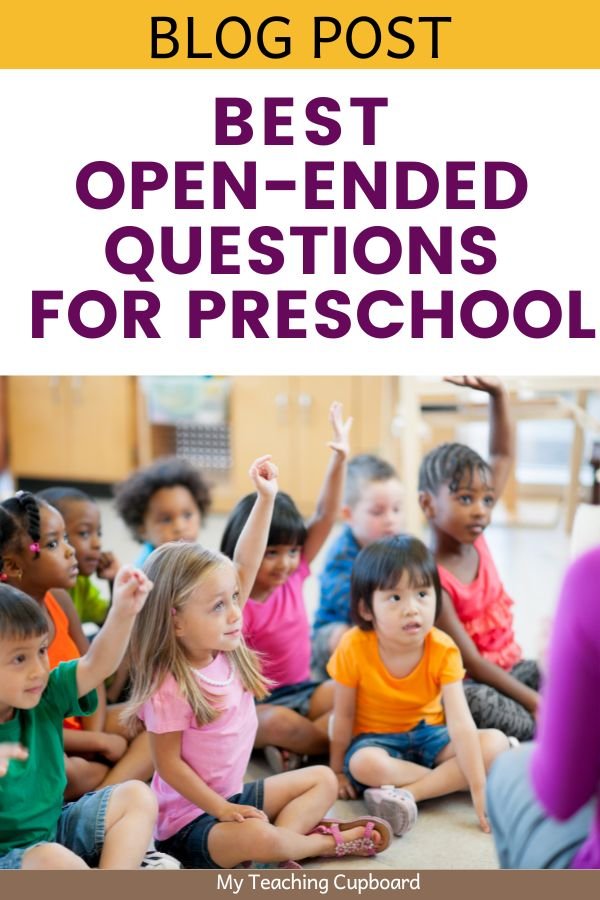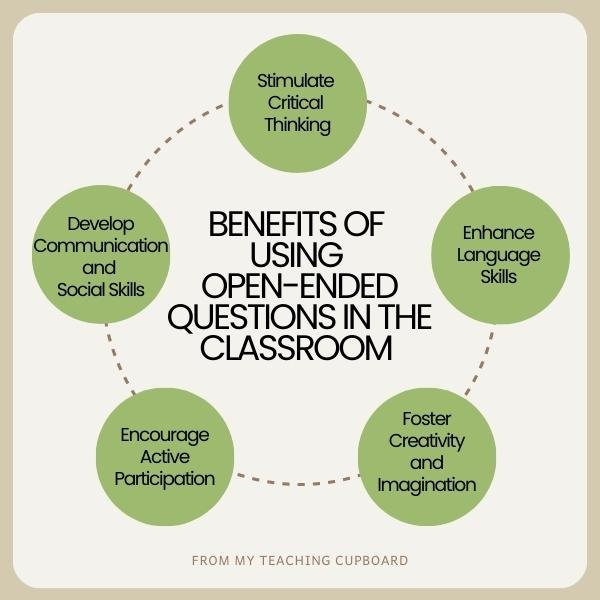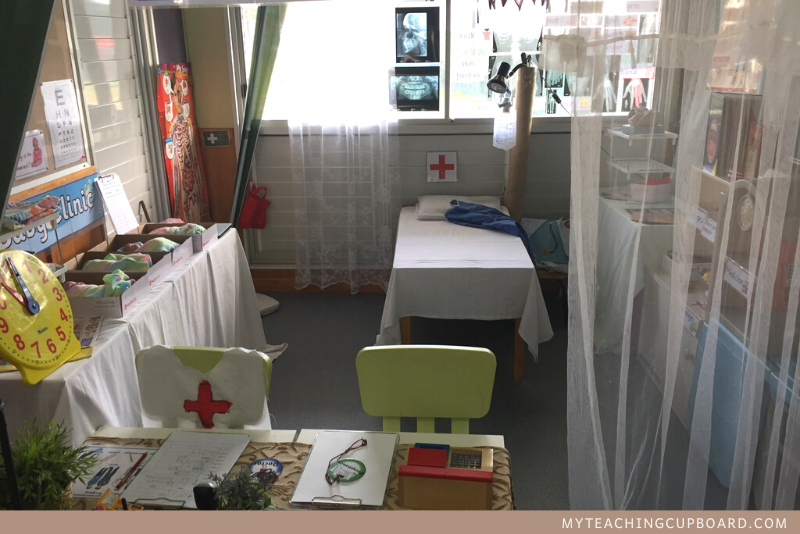Best Open-ended Questions for Preschool Kids
Interested in discovering the best open ended questions for the preschool kids in your classroom? As an early childhood educator, you understand the importance of fostering curiosity, critical thinking, and imagination in your young children. In preschool, children's minds are like sponges. They are so keen to absorb knowledge and explore the world around them.
So, in this blog post, we will explore the remarkable benefits of using open-ended questions in preschool. They really are a powerful tool you can use to encourage your preschoolers' cognitive development and language skills. Not only will you get a comprehensive list of carefully crafted open-ended questions in this blog post, but you’ll also discover some practical tips on how to engage and communicate effectively with your young learners.
If you are ready to captivate the imaginations of your preschoolers and take their thinking to the next level, read on!
What are open-ended questions?
Open-ended questions are thought-provoking questions that require more than a simple "yes" or "no" response. They encourage children to think critically, express their thoughts, and engage in meaningful conversations.
Unlike closed-ended questions, which have a predetermined answer, open-ended questions provide endless possibilities for exploration, imagination, and problem-solving.
As a preschool teacher, you play a vital role in your classroom. It’s your job to foster curiosity and provide learning experiences that promote the cognitive and emotional development of your young learners. One powerful tool you can use to significantly enhance your teaching is open-ended questions. Let’s look at why they are so valuable in preschool education.
The Benefits of Asking Open-Ended Questions
There are many benefits to asking your preschool students open-ended questions. If you want to get the most from your carefully planned learning experiences, you need to be using them. But why do open-ended questions matter so much in preschool education?
Open-ended questions…
Stimulate Critical Thinking: By posing open-ended questions, you stimulate your preschoolers' critical thinking skills. These questions encourage them to analyse, evaluate, and reflect upon different aspects of a topic, thereby promoting deeper understanding and higher-order thinking skills.
Enhance Language Skills: Open-ended questions provide opportunities for children to expand their vocabulary, practice sentence formation, and express their ideas in a coherent and articulate way. Through engaging in discussions sparked by open-ended questions, preschoolers develop strong language skills that will serve as a foundation for future academic success.
Foster Creativity and Imagination: Preschoolers have vivid imaginations and boundless creativity. Open-ended questions tap into these innate traits by inviting children to explore, create, and invent. They encourage imaginative play, problem-solving, and the development of innovative ideas.
Encourage Active Participation: Open-ended questions promote active participation and involvement from every child in the classroom. They can help you to create an inclusive learning environment where children feel valued and empowered to contribute their unique perspectives, experiences, and ideas.
Develop Communication and Social Skills: By engaging in conversations prompted by open-ended questions, preschoolers develop crucial communication and social skills. They learn to listen attentively, take turns speaking, and respect others' opinions. These skills lay the foundation for effective communication and collaboration throughout their entire lives.
Now that you have an understanding of what open-ended questions are and why they are so valuable in preschool education, let's explore the difference between an open-ended question and a closed question. When you can differentiate between the two, you will find it much easier to formulate and use open-ended questions in your classroom interactions.
The Difference between Open and Closed Questions
Open-ended questions and closed-ended questions are two distinct types of inquiries that elicit very different types of responses. Here's a breakdown of the differences between these question types:
Open-Ended Questions:
Definition: Open-ended questions are queries that do not have a specific or predetermined answer. They encourage individuals to provide detailed, thoughtful, and subjective responses.
Response Format: Open-ended questions prompt individuals to provide a more elaborate and personalised answer, using their own words and thoughts.
Example: "What do you think will happen if you add more blocks to your tower?"
Purpose:
Encourages critical thinking and reflection.
Promotes discussion and exploration of various perspectives.
Stimulates creativity, imagination, and problem-solving skills.
Fosters communication and language development.
Closed-Ended Questions:
Definition: Closed-ended questions are queries with a limited set of predetermined response options, often requiring a simple "yes" or "no" or a specific correct answer choice.
Response Format: Closed-ended questions offer individuals a constrained set of choices or a fixed answer format.
Example: "How many blocks are in your tower?" or "What colour is that block?"
Purpose:
Seeks specific information or confirmation.
Provides clarity on factual matters.
Limits the range of possible responses.
Facilitates decision-making or a quick response.
I’m not saying closed ended questions are bad and should not be used in a preschool classroom. Close ended questions are extremely useful in certain scenarios. You need to ask closed questions to gather specific information or verify facts. Many of our assessment pieces use closed questions and require a specific answer. Something to consider though - Maybe we should ask more divergent questions if we want to effectively assess a child's learning?
Open ended questions are the types of questions you ask a child when you want to get a more detailed response. They are good questions for encouraging deeper thinking and will help you to explore a child’s individual ideas and perspectives. There's no real right answer or wrong answer for an open ended question. Open-ended questioning is all about developing thinking skills and oral language development.
A combination of both question types is actually an excellent way to foster engagement, critical thinking, and meaningful conversations. Try to use a variety of questions!!
Now, let's explore some more practical examples of open questions that you can use in your play-based classroom. By using these questions effectively, you'll not only enhance your students’ learning experiences, but you’ll also increase their engagement and curiosity.
Using Open-Ended Questions in a Play Based Classroom
Preschool and kindergarten teachers have a unique opportunity to integrate open-ended questions seamlessly into their interactions and planning for play-based learning experiences.
When you use these types of questions, you can create a learning environment that encourages curiosity, problem-solving, and imagination.
Engaging in Meaningful Conversations:
During investigation time, observe your children's activities and ask open-ended questions that spark conversation and encourage them to think critically. For example:
"What do you think will happen next?"
"Why did you choose those colours for your painting?"
"How can we make this block tower even taller and more stable?"
Facilitating Reflection and Evaluation:
After your play-based investigations, it is very important to give your students the opportunity to reflect on their experiences. Reflection time is a crucial part of our daily investigation session.
During reflection time, ask open-ended questions that prompt your students to evaluate their actions and outcomes. For example:
"What was the most difficult part of building your tower?"
"How did you feel when you solved that problem?"
"What would you do differently next time?"
Planning Play-Based Learning Experiences:
When designing your play-based learning invitations, consider incorporating open-ended questions into your provocations. This will take your learning invitations to another level and encourage your students to explore further and think more deeply. For example:
"How can we make this area more like a real hospital?"
"What materials can we use to build a bridge that can hold the weight of this dump truck?"
"How can we use what we are learning about in maths to help us measure this water?"
If you would like to learn more about using open-ended questions to promote higher order thinking, you will want to read this blog post: Open-ended Questions Promote Higher Order Thinking
Higher order thinking is a focus in every curriculum and with every age group. It’s not just for preschool children. Older children benefit from this type of questioning too. All teachers can enrich their student’s academic and social learning by encouraging a child’s natural curiosity. Click the picture here to read in detail how to use open-ended questions in the classroom to promote higher order thinking skills.
Encouraging Collaboration and Communication:
Open-ended questions can facilitate collaborative play and will definitely develop better communication skills. You can encourage your children to share their ideas, negotiate roles, and solve problems together through questions like:
"How can you work together to build a castle out of these blocks?"
"What ways can you think of to share these cars for your game?"
"How can you help each other solve this puzzle?"
Embracing Imagination and Creativity:
Open-ended questions are a great way to ignite children's imagination and support creative thinking. Ask open-ended questions that encourage your students to expand on their ideas and explore possibilities further. For example:
"What kind of magical creature could you add to this fairy garden?"
"If you could build anything with these recycled materials, what would it be?"
"What is a new story you could create for this book character?"
By using open-ended questions in your interactions during investigative play sessions and at reflection time, you’ll be well on your way to creating a rich and dynamic learning environment that nurtures critical thinking, collaboration, communication, and creativity.
If you want to use more open-ended questions in your play-based classroom and foster higher-order thinking skills in your little learners, you will love this great resource. I have designed 30 beautiful open-ended question prompts you can print and display in your classroom. They just might be my favourite thing for helping me ask this type of question.
I place these thoughtfully designed prompts around my classroom and at learning invitations to serve as a gentle nudge to spark meaningful conversations with my children. They really help me to better understand my children's ideas and thinking.
These prompts have been carefully designed to stimulate curiosity and empower children to explore their thoughts, ideas, and perspectives. They are such good conversation starters!
By using them in your learning invitations, they can prompt you to start a rich discussion and a lively conversation that goes beyond a simple one-word response. They act as catalysts for critical thinking and will invite your students to analyse, evaluate, and problem-solve.
Elevate the learning opportunities in your classroom and align your questions to your learning intentions by using these prompts to guide you. Keeping your curriculum learning intentions in mind, you can use my prompts as a springboard into curriculum-aligned discussions during investigations and at reflection time.
I even printed a smaller version and placed them on a key ring so I have an easy-to-carry list of open-ended questions all ready to use. I have them with me as I move around the room during investigations and often use them again during our reflection time. They give me a great starting point for asking these kinds of questions.
More Examples of Close-Ended Questions in Preschool
Is the sky blue or green?
Do you like apples?
Can a fish fly?
Did you have fun at first break today?
Is a circle a shape?
Are elephants bigger than cats?
Do you want a red or blue pencil to colour with?
Did you brush your teeth this morning?
Is it raining outside?
Is your favourite colour red?
Did you finish the puzzle?
More Examples of Open-Ended Questions in Preschool
Why is the sky a different colour today?
Tell me about your favourite fruit and why you like it.
How do you think a fish moves underwater?
What was the most exciting thing you did at first break today?
Can you tell me how you know this is a circle?
How are elephants and cats different from each other?
How could you colour this in a different way?
What are some things you do to keep your teeth healthy?
What can you tell me about the weather today?
What colours make you feel happy? Why?
How did you feel when you finished the puzzle? What strategies did you use to solve it?
Remember, open-ended questions encourage children to think, express their thoughts, and provide more detailed responses.
Close-ended questions typically have straightforward answers.
Balancing both types of questions is the best way to ensure your interactions foster a well-rounded and engaging conversation that develops cognitive and emotional skills and also promotes language development.
Communication Skills and Oral Language Development
The best thing about using open-ended questions in preschool is the remarkable effect they have on oral language development. Open-ended questions are vital in developing communication skills and oral language development in preschoolers.
Here's how they contribute to the development of oral language skills and why they are crucial:
Expression of Thoughts and Ideas: Open-ended questions provide an important opportunity for preschoolers to express their thoughts, ideas, and opinions meaningfully. By encouraging children in the early years to articulate their responses, they can practice formulating sentences, organise their thoughts, and convey their messages effectively. This practice enhances their ability to communicate their needs, experiences, and perspectives.
Vocabulary Expansion: When children respond to open-ended questions, they have the freedom to use a wider range of vocabulary. They learn new words and phrases through exposure and context, which enriches their vocabulary bank. Regular engagement with open-ended questions helps preschoolers develop a more extensive and diverse vocabulary, facilitating better communication skills as they grow.
Sentence Development: Open-ended questions encourage preschoolers to construct complete sentences to express their thoughts. As they engage in conversations and provide detailed responses, they naturally practice sentence formation, including sentence structure, grammar, and word order. Regular exposure to open-ended questions strengthens their sentence development skills, leading to clearer and more coherent communication.
Active Listening: Open-ended questions promote active listening skills in preschoolers. When asked to respond thoughtfully, children must pay attention to the question, understand its meaning, and process the information. This cultivates their ability to listen actively, comprehend verbal cues, and respond appropriately, fostering effective communication and interaction with others.
Conversation Skills: Engaging in conversations sparked by open-ended questions enhances preschoolers' conversation skills. They learn turn-taking, listening to others, waiting for their chance to speak, and responding appropriately. Through these interactions, children develop other conversational skills like maintaining eye contact, using polite language and staying engaged in the discussion too. These skills are vital for effective communication and building positive relationships. Great conversations begin with great questions!
Effective communication skills and oral language development are crucial for preschoolers because these skills form the foundation for their future academic success and social interactions.
Strong communication skills empower children to express themselves confidently, engage in meaningful conversations, build relationships, and participate actively in classroom activities.
Open-ended questions are a powerful tool to nurture oral language and develop verbal skills. They foster confidence in language and give children the opportunity to effectively convey their thoughts and ideas from an early age.
Tips for Asking Open-Ended Questions to Preschoolers
When it comes to asking open-ended questions to preschoolers, here are some valuable tips for preschool teachers:
Use clear and simple language: The first thing you need to do is to ensure that your questions are age-appropriate and expressed in clear and simple language that preschoolers can understand. Avoid using complex vocabulary or convoluted sentence structures that might confuse them.
Give wait time: After asking an open-ended question, provide enough waiting time for your children to process the question and formulate their responses. Preschoolers may need a little extra time to gather their thoughts and find the words to express themselves. Patience is the key!
Encourage thinking and reflection: Open-ended questions are meant to promote critical thinking and reflection. Encourage children to think deeply and consider different possibilities or perspectives. Avoid rushing them for a quick answer, and instead, ask follow-up questions that delve further into their initial responses so they can provide a more meaningful answer.
Provide support and scaffolding: At first, some preschoolers may struggle with generating detailed responses. Offer support and scaffolding by providing prompts, examples, or additional information that can help stimulate thinking and expand a child's answer. Gradually reduce the level of support as they become more comfortable and confident in responding independently.
Emphasise the process over the correct answer: With open-ended questions, focus on the process of thinking, reasoning, and expressing ideas rather than seeking the answer you might have in your mind. Encourage children to explain their thought processes, share their reasoning, and explore various possibilities together. This helps foster creativity, critical thinking, and confidence in their abilities.
Celebrate and validate all responses: When children respond to open-ended questions, celebrate and validate their efforts. This should happen regardless of how correct you think their response might be. Encourage a positive and supportive environment where every response is valued and respected. This builds children's confidence, encourages participation, and promotes idea sharing.
Use open-ended questions in various contexts: Integrate open-ended questions into different learning experiences, including play-based investigations, circle time discussions, storytelling, and explicit teaching lessons. By incorporating open-ended questions across various learning contexts, you will be providing children with diverse opportunities to practice their communication and critical thinking skills.
Use open-ended questions to extend learning: Open-ended questions can be used to extend children's learning experiences. Ask questions that prompt them to reflect on what they have learned, make connections to their experiences, or explore further possibilities. This helps deepen their understanding and encourages them to apply their knowledge in different contexts.
Remember, asking open-ended questions is not just about eliciting responses. It's about creating a stimulating environment that nurtures children's curiosity, critical thinking, and communication skills. With these tips in mind, you'll be well-equipped to engage preschoolers in meaningful conversations and promote their overall development.
Conclusion
In conclusion, using open-ended questions in preschool and kindergarten classrooms can have a profound impact on your students’ communication skills, oral language development, and overall cognitive growth.
These types of questions, will help you to create an environment that fosters critical thinking, creativity, and meaningful interactions.
Use open ended questions that encourage children to express their thoughts, ideas, and emotions, expand their vocabulary and sentence development while also nurturing their ability to actively listen and engage in conversations. Through the process of answering open-ended questions, children develop valuable skills such as problem-solving, reflection, and effective communication skills.
Remember to
use clear and simple language.
provide wait time for responses.
encourage thinking and reflection.
celebrate each child's contribution.
Emphasise the process of thinking and reasoning rather than seeking a specific correct answer. You need to create a supportive environment where all responses are valued and respected.
Don’t forget to purchase my printable prompts for easy ways to harness the benefits of open-ended questions in your classroom. These prompts will be a valuable resource providing you with lots of questions to engage your preschoolers in meaningful conversations and learning experiences.
By incorporating open-ended questions and using the right resources, you can create an enriching and dynamic learning environment where children's voices are heard, their imaginations flourish, and their communication skills thrive.
Please consider sharing this blog post with other educators and help them to gain a better understanding of the topic. I'm sure they would like to discover and use the best open ended questions for preschool kids in their classrooms too.
Just CLICK the sharing box below.👇













